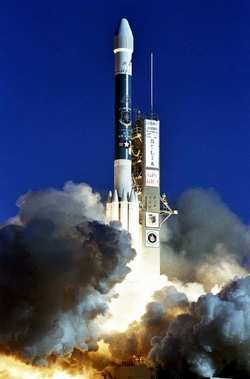Tue, Mar 24, 2009
First Delta II Launch Was Also A GPS Flight
 A United Launch Alliance Delta II rocket successfully launched
the Air Force's Global Positioning Satellite IIR-20(M) into orbit
from Cape Canaveral's Space Launch Complex 17A at 4:34 am EDT. This
was the 47th successful GPS launch for the Delta II in its storied
20-year history.
A United Launch Alliance Delta II rocket successfully launched
the Air Force's Global Positioning Satellite IIR-20(M) into orbit
from Cape Canaveral's Space Launch Complex 17A at 4:34 am EDT. This
was the 47th successful GPS launch for the Delta II in its storied
20-year history.
The very first Delta II launch on February 14, 1989 was the
NAVSTAR II-1 launch. NAVSTAR is now commonly known as GPS.
Following a nominal 1 hour and 8 minute flight, the rocket
deployed the GPS IIR-20(M) spacecraft, the seventh modernized
NAVSTAR Global Positioning System Block II R-M military navigation
satellite. GPS is a space-based positioning system designed and
operated as a 24-satellite constellation that provides precision
navigation and timing information to military and civilian users
worldwide.
"Congratulations to the Air Force and all of our mission
partners on today's successful GPS satellite launch," said Jim
Sponnick, vice president, Delta Product Line. "One third of the 140
successful Delta II launches have been dedicated to GPS satellites.
The ULA Delta team is extremely proud of the role we've played in
launching this incredible satellite constellation. During the past
two decades, GPS has changed how people navigate around their
neighborhoods and around the globe. GPS has also greatly improved
military operations as well as numerous maritime, aircraft, and
business operations worldwide."
Designed to operate for 10 years, GPS satellites orbit the Earth
every 12 hours, emitting continuous navigation signals. With the
proper equipment, users can receive these signals to calculate
time, location and velocity. In addition to its military use, GPS
satellites provide directional assistance to civilian users around
the world.
The ULA Delta II 7925-9.5 configuration vehicle featured an ULA
first stage booster powered by a Pratt & Whitney Rocketdyne
RS-27A main engine and nine Alliant Techsystems (ATK) strap-on
solid rocket motors. An Aerojet AJ10-118K engine powered the second
stage. A spin-stabilized Star-48B solid-rocket motor built by ATK
boosted the third stage. The payload was encased by a
9.5-foot-diameter metallic payload fairing.
ULA's next launch is the Air Force Wideband Global SATCOM-2
mission scheduled aboard an Atlas V from SLC-41 at Cape Canaveral.
A specific launch date has not been established.
More News
Also: B-29 Superfortress Reunion, FAA Wants Controllers, Spirit Airlines Pulls Back, Gogo Galileo Van's Aircraft posted a short video recapping the goings-on around their reorganiz>[...]
Light Gun A handheld directional light signaling device which emits a brilliant narrow beam of white, green, or red light as selected by the tower controller. The color and type of>[...]
"The journey to this achievement started nearly a decade ago when a freshly commissioned Gentry, driven by a fascination with new technologies and a desire to contribute significan>[...]
"Our driven and innovative team of military and civilian Airmen delivers combat power daily, ensuring our nation is ready today and tomorrow." Source: General Duke Richardson, AFMC>[...]
Aircraft Conflict Predicted conflict, within EDST of two aircraft, or between aircraft and airspace. A Red alert is used for conflicts when the predicted minimum separation is 5 na>[...]
 Airborne 04.16.24: RV Update, Affordable Flying Expo, Diamond Lil
Airborne 04.16.24: RV Update, Affordable Flying Expo, Diamond Lil ANN's Daily Aero-Term (04.20.24): Light Gun
ANN's Daily Aero-Term (04.20.24): Light Gun Aero-News: Quote of the Day (04.20.24)
Aero-News: Quote of the Day (04.20.24) Aero-News: Quote of the Day (04.21.24)
Aero-News: Quote of the Day (04.21.24) ANN's Daily Aero-Term (04.21.24): Aircraft Conflict
ANN's Daily Aero-Term (04.21.24): Aircraft Conflict



